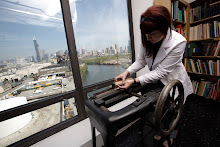 [Wang Qingsong]
[Wang Qingsong]After reading through Reversed Images: Representations of Shanghai and Its Contemporary Material Cultural, Contemporary Chinese Art: Primary Documents, the catalog from the exhibit Made in China at the MCA in Chicago, as well as viewing multiple video clips from the Tiananmen Square Protests, it is staggering the review these collective pieces and reflect upon how much China has changed just in my lifetime.
The format of the catalog to the Made in China exhibit mimics the wallpaper layout of the show. It functions as a type of time-line, exploring China from its agriculturally rich history throughout its political and governmental transformations to the overwhelming urbanization efforts it has and continues to undertake. The time-line operates in such a way that sections in different ink colors, break up titling to separate red ink for representing "formal, ordered or planned governmental decisions, while blue ink covers the informal, organic or ad-hoc responses and reactions to the enforced policies or events. Tricia Van Eck, states within the catalog that the wallpaper setup encourages the viewer to further interact with other visitors of the show and to answer a set of questions Jiang Jun poses. As the Editor in Chief to Urban China, the only Chinese magazine which researches urbanism in China, Jiang Jun asks the viewer a series of questions focusing on seeing China in many different forms. Some of the more fascinating questions center around looking to "active" public spaces in China and what differentiates them from those in the United States?
In the excerpts from the Tiananmen Square Mini Documentary, the narration begins to explain that Tiananmen Square is the largest public space in the world, intentionally built on an inhuman scale which in part means to reduce humans to the importance of the state. Stated by Michel de Certeau that some specific sites are nearly impossible to separate from specific words, Tiananmen Square rises to the top of that list. The space is seeped in a history of political events, including the protests of 1989 in which hundreds of protesters were killed, possibly many more. A site like Tiananmen Square is so specific and yet evokes such incredibly varied responses, based on emotion, interaction and the preconceived notions which seem eternally linked with the public.
Jiang Jun also asks us how an active "public" can be generated in China? Even though China is a country full of cities that are at the forefront of reigning powers in the global economy, I would argue that an uncensored internet could create a more active public. Even though in many developed countries, millions do not have access to the internet for multiple reasons, in most areas of China even those that do have access are limited due to the State. What does it say about a society that keep its people "in"? One of the confusing aspects of this is that the country plays on the international stage of trade and economic powers, especially due to its population who creates the goods, but prohibits them from total information.
 [Tian Taiquan]
[Tian Taiquan]Throughout the Contemporary Chinese Art: Primary Documents article excerpts, artists such as Huang Yan, Zhan Wang and Chen Shaoxiong examine the changing urbanism within cities that looks to infrastructure and cultural shifts. Between making rubbings of buildings before, during and after demolition, creating mirrored surfaced "artificial rockery" and attempting to photograph every aspect of an urban landscape, these artists attempt to understand their very temporal and transitional spaces. Chen Shaoxiong's attempts at focusing on every object, including all seemingly insignificant, in an effort to examine and memorialize his rapidly changing Guangzhou is reminiscent of artists like Christopher Wool, Moyra Davey and Roy Colmer working in New York City.
 [Zhan Wang]
[Zhan Wang] [Chen Shaoxiong]
[Chen Shaoxiong]In addition to these works, an Australian Dateline feature named China's Ghost Cities and Malls investigates the booming large-scale infrastructure projects in China. Millions of apartments and commercial spaces have sat vacant for years and per current predictions will continue to remain unoccupied. The unbelievable costs of home ownership and the strict conditions in which that dream could be possible seem so unattainable even to very high earners. Facts stated that some projects require a 50% down-payment on property followed by the requirement of the balance to be payed off in 3 years. The destruction of historic neighborhoods followed by the replacement of huge redevelopment projects is so focused on setting the GDP high, that everything else suffers. State-assisted housing doesn't appear as an option even in a state controlled housing market. Several artists are following these occurrences photographically, including Edward Burtynsky, Zhang Xiao and Sze Tsung Leong.
 [Edward Burtynsky]
[Edward Burtynsky]

 [3 images: Zhang Xiao]
[3 images: Zhang Xiao]Although a little generalized, the following video explores "public spaces" within and around private developments in a few areas of urban China.
While exploring Chinese artists in the contemporary sphere, I ran across this great site, Conscientious, which leads to many images and personal artist sites. Many of the works by the Chinese photographers featured explore the multiple layers and intertwining cultural histories of China both before and after the Cultural Revolution. It is straightforward enough to point out multiple problems that China dwells within, not limited to: [gross negligence of human rights, Tibet, censorship, overpowering State control and massive urban renewal projects], but not as clear as how to shift them towards repair. Much of the Made in China show explores how to expand the dialogue surrounding these issues and how individuals, including artists, can tangibly and visually create changes for the reimagination of China.
 [O Zhang]
[O Zhang]
No comments:
Post a Comment